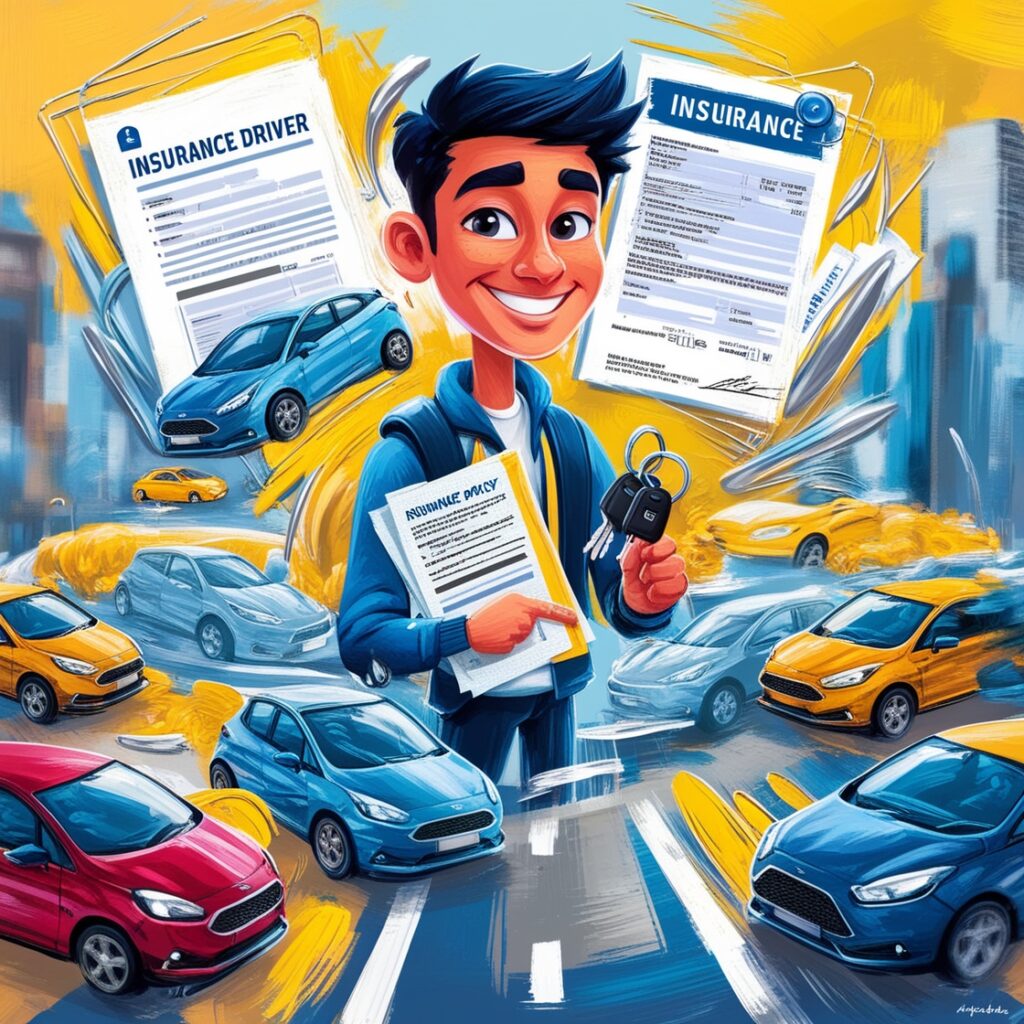Insurance Coverage
Coverage Tailored to Your Unique Needs
Cheapest Car Insurance For Students

The cost of adding an 18-year-old college student onto their parent’s auto insurance policy is $2,436 a month, or $203 per month. Many students only work part-time and just can’t afford $203 every month. The good news is by taking advantage of proven money-saving tips, it’s possible to get the cheapest car insurance for students.
For many students, getting their first car is an exciting milestone that represents newfound freedom and independence. However, this freedom comes with a significant financial responsibility, the dreaded auto insurance payment. Young drivers, particularly students, often face some of the highest insurance premiums due to their lack of driving experience and higher statistical risk of accidents. This article will provide helpful strategies for getting cheap car insurance for students.
An Overall Look At Car Insurance for Students
- Legal Requirements: Most states require drivers to have a minimum level of car insurance coverage. This typically includes liability coverage for bodily injury and property damage.
- Types of Coverage:
-
- Liability: Covers damages you cause to others
- Collision: Covers damage to your car from accidents
- Comprehensive: Covers non-collision related damage (e.g., theft, vandalism)
- Personal Injury Protection: Covers medical expenses for you and your passengers
- Uninsured/Underinsured Motorist: Protects you if you’re hit by a driver without adequate insurance
- Factors Affecting Rates: Age, driving experience, academic performance, type of car, and location all play a role in determining insurance rates for students.
- Parental Policies: Many students can save money by staying on their parent’s policy rather than getting their own.
Understanding these basics is crucial for students looking to find the cheapest car insurance options while maintaining adequate coverage.
Factors Affecting Car Insurance Rates for Students

Several factors contribute to the generally higher insurance rates for student drivers:
- Age and Experience: Younger drivers with less experience typically pay more for insurance due to higher accident rates among this demographic.
- Type of Vehicle: The make, model, and year of the car affect insurance rates. Newer, more expensive cars usually cost more to insure.
- Driving Record: Any accidents or traffic violations can significantly increase premiums.
- Credit Score: In many states, insurance companies use credit-based insurance scores to determine rates.
- Location: Urban areas with higher traffic density and crime rates often have higher insurance costs.
- Academic Performance: Many insurers offer discounts for students with good grades.
- Annual Mileage: Students who drive less may qualify for lower rates.
- Gender: In some states, male students may pay more than female students due to statistical differences in accident rates.
- Coverage Levels: Higher coverage limits and additional types of coverage increase premiums.
- Deductible Amount: Choosing a higher deductible can lower monthly premiums but it does increase out-of-pocket costs in the event of a claim.
Top Cheap Car Insurance Companies for Students
While rates can vary based on individual circumstances, the following insurance companies are known for offering competitive rates and special programs for student drivers:
- Geico: Often praised for its low rates, Geico offers a good student discount and a discount for completing a defensive driving course.
- State Farm: Provides several discounts for students, including the Steer Clear program for drivers under 25 and the good student discount.
- Progressive: Offers a good student discount and the Snapshot program, which can lead to lower rates based on safe driving habits.
- Allstate: Features the Smart Student Discount for full-time students with good grades and the Drivewise program to reward safe driving.
- USAA: Available to military families, USAA often offers some of the lowest rates for students and includes a good student discount.
- Erie Insurance: While not available in all states, Erie is known for competitive rates and offers both good student and driver training discounts.
- Nationwide: Provides a good student discount and the SmartRide program, which can lead to lower rates based on safe driving habits.
- American Family Insurance: Offers a Teen Safe Driver program and good student discounts.
- Travelers: Features both good student discounts and a student away at school discount for those attending college over 100 miles from home.
- Liberty Mutual: Offers a good student discount and a RightTrack program to reward safe driving habits.
Proven Strategies For Getting Cheap Car Insurance For Students
- Maintain Good Grades: Many insurers offer substantial discounts for students who maintain a B average or better.
- Take a Defensive Driving Course: Completing an approved course can lead to discounts with many insurance providers.
- Choose a Safe, Affordable Car: Older, less expensive cars with good safety ratings typically cost less to insure.
- Increase Your Deductible: Opting for a higher deductible can lower monthly premiums, but be sure you can afford the higher out-of-pocket cost if you need to make a claim.
- Bundle Policies: If you have renter’s insurance or other policies, bundling them with your auto insurance can often lead to discounts.
- Drive Safely: Maintaining a clean driving record is crucial for keeping insurance costs down.
- Limit Your Mileage: Some insurers offer low-mileage discounts. Consider using public transportation or carpooling when possible.
- Improve Your Credit Score: In states where it’s allowed, a better credit score can lead to lower insurance rates.
- Shop Around Regularly: Insurance rates can change, so it’s wise to compare quotes from different providers annually.
- Consider Usage-Based Insurance: Programs that track your driving habits through a mobile app or device can lead to discounts for safe driving.
- Stay on Your Parents’ Policy: If possible, remaining on your parents’ policy is often cheaper than getting your own.
- Look for Student-Specific Discounts: Many insurers offer discounts for students who are away at college or maintain good grades.
By implementing a combination of these strategies, students can potentially save hundreds each year on their auto insurance premiums.
Special Insurance Discounts and Programs for Student Drivers

Insurance companies offer various discounts and programs specifically designed for student drivers. Being aware of these can lead to substantial savings:
- Good Student Discounts: Most major insurers offer discounts for students who maintain a B average (3.0 GPA) or higher. Discounts typically range from 10% to 25%.
- Student Away at School Discount: For students attending college more than 100 miles from home and not taking a car, many insurers offer discounts of up to 30%.
- Safe Driver Programs: Many insurance companies offer programs that track driving habits through a mobile app or device. Safe driving can lead to discounts of up to 30%.
- Driver’s Education Discounts: Completing an approved driver’s education course can lead to discounts with many insurers.
- Fraternity, Sorority, and Honor Society Discounts: Some insurers offer discounts for members of certain organizations.
- Alumni Association Discounts: Graduates may be eligible for discounts through their university’s alumni association.
- Military Discounts: Students in ROTC programs or from military families may be eligible for special discounts.
- Multi-Policy Discounts: Bundling auto insurance with renter’s insurance or other policies can lead to savings.
- Pay-in-Full Discounts: Some insurers offer discounts for paying the entire premium upfront rather than in monthly installments.
- Paperless Billing and Automatic Payment Discounts: Opting for electronic statements and automatic payments can sometimes lead to small discounts.
- Affiliation Discounts: Some insurers partner with universities to offer discounts to students and alumni of specific schools.
- Low Mileage Discounts: Students who don’t drive much may qualify for usage-based insurance programs or low mileage discounts.
Students should inquire about these and any other available discounts when shopping for insurance. It’s also important to note that discount availability and amounts can vary by state and insurer.
Comparison Shopping Student Auto Insurance Quotes
- Online Comparison Sites: Websites like The Zebra, Compare.com, and Insurify allow you to compare quotes from multiple insurers simultaneously.
- Insurance Company Websites: Most major insurers have online quote tools on their websites, allowing you to get personalized estimates quickly.
- Insurance Aggregators: Sites like NerdWallet and Policygenius provide both comparison tools and educational resources about insurance.
- State Insurance Department Websites: Many state insurance departments offer guides and comparison tools specific to their state’s insurance market.
- Mobile Apps: Some insurers and third-party companies offer mobile apps for easy quote comparisons and policy management.
- Local Insurance Agents: While not an online tool, local agents can provide personalized advice and help you compare options from multiple insurers.
When using these tools, it’s important to keep in mind a few things:
- Provide accurate information to get the most reliable quotes.
- Compare quotes for the same coverage levels and deductibles to ensure a fair comparison.
- Look beyond just the price – consider the company’s reputation, customer service, and claims process.
- Be prepared to provide detailed information about your vehicle, driving history, and personal details.
Remember that online quotes are estimates, and the final price may change after a more detailed review of your information. It’s often beneficial to follow up with insurance agents or representatives to confirm quotes and ask about additional discounts that may not be reflected in online tools.
Having Adequate Auto Insurance Coverage Is Super Important
- Legal Requirements: Most states have minimum coverage requirements. Failing to meet these can result in fines, license suspension, or legal issues.
- Financial Protection: Adequate coverage protects you from potentially devastating financial consequences in case of a serious accident.
- Lender Requirements: If you have a car loan or lease, your lender will likely require certain coverage levels.
- Peace of Mind: Knowing you’re properly covered allows you to drive with confidence.
- Future Insurance Rates: Being underinsured can lead to higher rates in the future if you’re involved in an accident.
When considering coverage, students should:
- Understand state minimum requirements and consider if they’re sufficient for their needs.
- Evaluate their assets and choose liability limits that would adequately protect them.
- Consider collision and comprehensive coverage, especially for newer or more valuable vehicles.
- Assess the need for additional coverages like roadside assistance or rental car coverage.
- Understand the implications of choosing a higher deductible to lower premiums.
While it may be tempting to opt for the bare minimum coverage to save money, this approach can be risky. A single accident could result in out-of-pocket expenses far exceeding the savings from lower premiums. Students should aim to find a balance between affordable premiums and sufficient coverage to protect themselves financially.
Common Mistakes to Avoid When Choosing a Policy

- Focusing Solely on Price: While finding affordable insurance is important, the cheapest option isn’t always the best. Consider factors like coverage limits, deductibles, and the insurer’s reputation.
- Neglecting to Shop Around: Don’t assume one company will always offer the best rate. Insurance pricing can vary significantly between providers.
- Misunderstanding Coverage: Make sure you fully understand what your policy covers and what it doesn’t. Don’t hesitate to ask questions if something is unclear.
- Lying or Omitting Information: Being dishonest on your insurance application can lead to claim denials and policy cancellations.
- Ignoring Discounts: Failing to inquire about or take advantage of available discounts can result in unnecessarily high premiums.
- Choosing Inappropriate Deductibles: While a high deductible lowers premiums, make sure you can afford to pay it if you need to make a claim.
- Forgoing Important Coverage: Skipping collision or comprehensive coverage to save money can be costly if you’re in an accident or your car is stolen.
- Not Reviewing Policies Regularly: As circumstances change, your insurance needs may change too. Review your policy annually and after major life events.
- Assuming All Insurance Companies are the Same: Different insurers may treat factors like credit scores or driving history differently. Don’t assume you’ll get the same rate everywhere.
- Neglecting to Bundle Policies: Missing out on multi-policy discounts by having insurance with different companies can result in higher overall costs.
- Paying Monthly Instead of Annually: Many insurers offer discounts for paying the full premium upfront rather than in monthly installments.
- Not Considering Usage-Based Insurance: If you’re a safe driver who doesn’t drive much, you might be missing out on savings from usage-based programs.
By avoiding these mistakes, students can ensure they’re getting the most appropriate and affordable car insurance for their needs.
Future Trends in Student Car Insurance
The car insurance industry is constantly evolving, and several trends are likely to impact student insurance in the coming years:
- Increased Use of Telematics: Usage-based insurance programs using smartphone apps or plug-in devices are becoming more common, potentially offering significant savings for safe student drivers.
- Artificial Intelligence in Pricing: AI and machine learning are being used to create more personalized and accurate risk assessments, which could benefit responsible student drivers.
- Subscription-Based Insurance: Some companies are experimenting with flexible, subscription-style insurance that can be turned on and off as needed, which could be beneficial for students who only drive occasionally.
- Autonomous Vehicle Considerations: As self-driving technology advances, insurance models may shift to focus more on the vehicle’s systems rather than the driver’s characteristics.
- Cybersecurity Coverage: With cars becoming more connected, insurance policies may start to include coverage for cyber attacks on vehicles.
- Climate Change Impact: Increasing severe weather events may lead to changes in comprehensive coverage and pricing.
- Peer-to-Peer Insurance: This model, where groups of people pool their premiums to insure against risk, could provide cheaper options for student groups.
- Blockchain in Insurance: This technology could streamline claims processing and reduce fraud, potentially leading to lower premiums.
- Pay-Per-Mile Insurance: This model, where premiums are based on actual miles driven, could become more widespread and benefit students who don’t drive frequently.
- Increased Focus on Driver Education: Insurance companies may place greater emphasis on and provide more incentives for completing advanced driver training programs.
Students should stay informed about these trends as they could present new opportunities for savings and improved coverage in the future.
The Final Word On Getting The Cheapest Car Insurance For Students
Navigating the world of car insurance as a student can be challenging, but armed with the right information and strategies, it’s possible to find affordable coverage that meets your needs. Remember these key points:
- Understand the factors that affect your insurance rates, including age, driving experience, academic performance, and the type of car you drive.
- Take advantage of student-specific discounts and programs offered by insurance companies.
- Implement strategies to lower your insurance costs, such as maintaining good grades, taking defensive driving courses, and considering usage-based insurance programs.
- Use online comparison tools and shop around regularly to ensure you’re getting the best rates.
- Don’t sacrifice adequate coverage for a lower price – balance affordability with sufficient protection.
- Avoid common mistakes like focusing solely on price or neglecting to review your policy regularly.
- Stay informed about future trends in car insurance that may present new opportunities for savings.
By following these guidelines and continually educating yourself about car insurance, you can find the cheapest options that still provide the coverage you need. Remember, the cheapest car insurance for students isn’t just about the lowest price – it’s about finding the best value for your specific situation. Get your custom student car insurance quote online and save hundreds.

